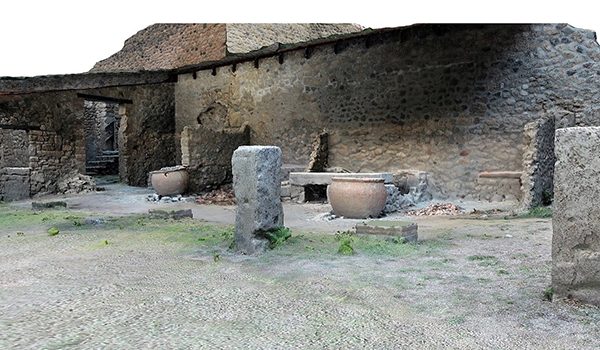The large tannery of Pompeii from restoration to valorisation, a positive example of public and private sector collaboration
Yet another important structure at Pompeii, namely the tannery of Regio I - the largest artisan workshop dedicated to the working of leather which has been found in the ancient city - will be able to be returned to public access. This is thanks to the restoration and valorisation interventions which are ongoing and which are the result of a successful public and private sector collaboration between the Archaeological Park of Pompeii and UNIC Concerie Italiane (‘The Italian Tanners’ Association),which has sponsored the project. It is an inspiring example which also bodes well for the path that the Archaeological Park of Pompeii is following in this direction, in a planned manner, through the activities of the recently established Fundraising Office.
The relationship between the Unione Nazionale Industria Conciaria and the Park is a strong one, which back in 2008 saw UNIC - Concerie Italiane contribute towards the architectural restoration of the tannery building, sponsoring the recovery of a part of the area formerly used for leather working. The two bodies have since renewed their collaboration through a sponsorship funding contract withLINEAPELLE srl,a company wholly owned by the UNIC group, in relation to a valorisation project which seeks to reopen the tannery complex to the public.
The project was recently launched under the operational and scientific direction of the Park, whose officials also oversaw its design. Interventions are currently underway to complete the road providing access to the building, the so-called Vicolo del Conciapelle, which is currently patchy and interrupted as a result of the bombs which struck the archaeological site of Pompeii in August and September 1943. At the same time, restoration work is proceeding on the areas and tools linked to the tanning of hides, as well as the summer triclinium (banqueting hall) in which the owner of the workshop complex welcomed his guests.
These initial interventions will be followed by the creation of a didactic exhibition that will not only illustrate to visitors how, in ancient times, the process of leather working was carried out, but which will also allow the display or reproduction of the original tools that were used in ancient times, in line with the ‘open-air museum’ model which has already been successfully tested at Pompeii.
“The agreement between the APP and UNIC - Concerie Italiane is the expression of a synergy between the public and private sectors, which is increasingly important today for incentivising forms of safeguarding and valorising cultural heritage”, declared Massimo Osanna, Director General of Museums. “The companies which choose to offer their support through sponsorship are expressing a great awareness of the value of cultural heritage as a collective asset, as well as a farsightedness on the creation of new processes which derive from the interaction of art and culture.
It is for this reason, and in the wake of this fine example, that the Archaeological Park has decided to invest in this direction, through the establishment of a Fundraising Office designed to promote collaboration between the public and private sectors in an organic and structured manner, with expected results that go well beyond the ‘relationship of collaboration and mutual benefit’, as demonstrated by the video testimony of UNIC. The synergy of the public and private sectors, and the consolidation of entrepreneurial realities with the culture of the relevant area are, indeed, able to generate new cultural processes, with unexpected socio-economic repercussions”.
From today, it will be easier to become involved and immediately establish a dialogue with the goal of activating the different forms of collaboration between the Public Administration and private companies, for all those who are interested in supporting the work of the Park - aimed at the recovery, restoration, planned maintenance, management, opening to the public and valorisation of movable and immovable cultural property. The Fundraising Office has the objective of gathering ideas and proposals, and of studying and planning works, alongside cultural patrons.
THE TANNERY and the PROCESS OF LEATHER WORKING IN ANCIENT POMPEII
Brought to light in the late 19th century, and located in the Regio I of the excavations (Insula 5), the tannery works were identified as such on the basis of epigraphic evidence, the utensils found during the excavations and additionally the tools employed more broadly in the productive process, which were very similar to those used in medieval and modern tanneries.
The workshop was established around the mid-1st century AD on the site of an earlier dwelling, and came to occupy almost the entire insula. As a consequence of the damage suffered during the earthquake of AD 62, the workshop subsequently underwent significant changes, which rendered it more functional, and gave it its current appearance.
The various operations which together comprised the process of leather working were conducted in functionally distinct parts of the building: the washing of the hides, which required the use of foul-smelling substances, was probably carried out inside the water-fed dolia below the portico, or perhaps on the banks of the Sarno far from the complex. The tanning itself however, involving the maceration of the hides, took place inside the fifteen large cylindrical tanks which were located in one of the rooms of the building. Finally, the hides were beaten below the porticoed area and worked in the small rooms arranged one after the other on the east side of the peristyle, and separated from each other by low transverse walls. Adjacent to the west wall of the peristyle we also find a large summer triclinium which was set aside for the guests of the coriarius (business owner), whose residence was located within the complex.
Within the context of ancient artisan manufacturing, the Pompeii tannery constitutes an exceptional record.


